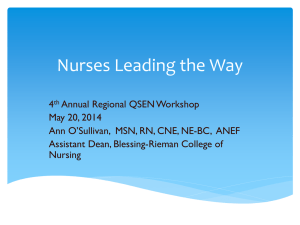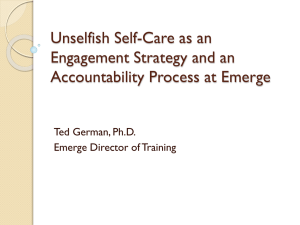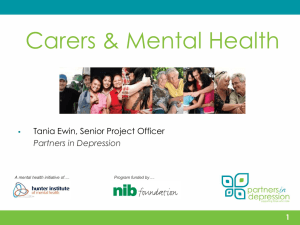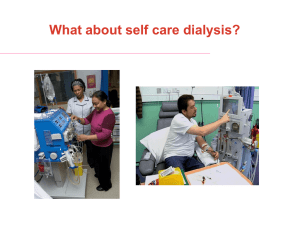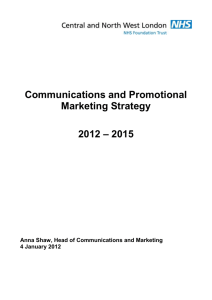- NHS West London Clinical Commissioning Group
advertisement
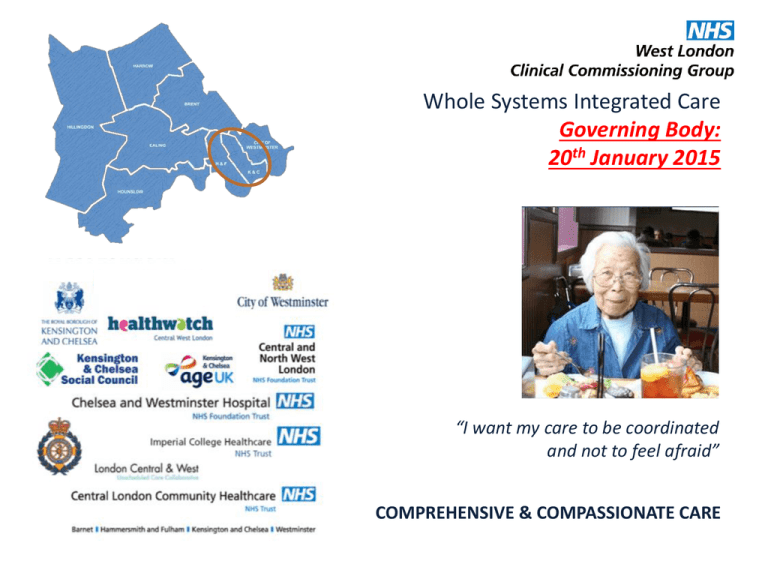
Whole Systems Integrated Care Governing Body: 20th January 2015 “I want my care to be coordinated and not to feel afraid” COMPREHENSIVE & COMPASSIONATE CARE 1 Objectives for today Agree the high-level co-designed West London Older Adult Whole Systems Model of Care Agree approach to phasing and implementation Agree high-level cost assumptions, upon which to build a more detailed cost model 2 Co-designed model of care – who and how have we worked together Two major c-design events West London Health & Wellbeing Board West London CCG Governing Board West London Out of Hospital Committee West London Whole Systems Patients Panel West London Whole Systems Steering Group Putting Patients First & Model of Care Working Group West London Primary Care Design Group West London Social Care Working Group NWL Collaborative design groups 3 Based on the service user & staff feedback the working groups have identified 6 core elements of a proposed Whole Systems Model of care 1 Centred around the holistic needs of the service users and their carers, involving them in all decisions while providing with simpler access and a shared care plan 2 Personalised and tailored to changing health as well as social needs, covering planned as well as reactive needs and one that empowers self-care 3 Has a clear point of accountability (both for clinical & nonclinical outcomes ) with a core team that reflects user’s needs and helps coordinate their care 4 Is supported by a number of local operational whole systems bases where joint teams work on a day to day basis coordinating the care and tracking outcomes 5 Helps coordinate the services (via the base) as needed from different organisations, on behalf of the service users and their carers 6 Is brought together by shared cultural values & ethos, organisations working as an Accountable Care Partnership that is commissioned to single set of outcomes and is enabled by shared systems & incentives 4 Co-designed model of care – West London Whole systems Model of Care Shared care plan for health & social needs Single point of access Equally involved Carers & family Involved in making decisions for care 1 Service users 2 Tier 1: Over 65s with well managed LTCs Tier 0: Mostly healthy over 65s Tier 3: Complex and / or with intense needs Tier 2: At risk, under monitoring Increasing health and social care needs Users & carers empowered for self-care CIS teams Tailored increase in resources for self-care, carer involvement and primary care for over 75s e.g., longer appointments, 24x7 GP cover Operational base Home 5 6 Whole systems case managers Named GP 3 4 Prim. care navigators / Int. care workers Dist. Nurses Soc. care workers Learning disabilities Groups of practices Physios Pool of case managers & service leads Mental Health Voluntary services ▪ ▪ ▪ GP practice Housing & Benefits HCAs Advanced diagnostics SPA admins North / South Hub PCNs Pharmacy Relevant CIS team members, RR, In-reach etc. OTs GP-on call cover Pharmacy Major hospital Base coordinator & Clinical lead Supports a fixed number of practices Older adult Support teams Continuing care North & South Hubs Acute Elective Specialist 999, CIS, LAS, OOH,UCC Acute NEL Cultural and people integration: of local base staff moving towards a single organisation Financial integration: Capitated budgets, aligned financial incentives in the long terms Systems and operational integration: Shared IT and systems supported with robust legal and governance arrangements 5 • • 4 Mental health Dementia, depression/anxiety • 5 Community development Community champions, links to other services (e.g. Housing, CAB) 6 Carers Befriending, support GP referral PCN or Case Manager referral Self-referral On-line 3 Self-care – condition specific services Expert patient Community outreach 2 Self-management – lifestyle services – to support changes in behaviour Health Trainers, Weight management, smoking cessation Professional ‘trainers’ 1 Befriending services Community champions, links across and between communities Peer-to-peer, group and self-support Co-designed model of care – high-level self-care model Co-designed model of care – self-care, the baseline and next steps • • • • • Voluntary sector are committed and excited to be a part of this Recent data suggests that there are around 1,172 registered VCOs in K&C (further data required on QPP) KCSC are aware of around 500 active organisations with 2009/10 estimates of income of approximately £127m in total, £7m of which came from NHS, Social Care and Public health (which we expect to have staid the same in real terms) While that funding (from NHS, Social Care & Public health) provides for services for all age groups we believe about half of it is utilised towards specific services for adults Over the next 2-3 months we want to continue our work with this group to • Create an in depth baseline of what exists and how it is used • Identify which services fit with our high-level model and how they could be better integrated in the whole systems pathways • Develop internal capability and a more integrated relationship with the joint health and social care commissioners to enhance / monitor any of these services for supporting the whole systems proposals • Work with the teams on the ground to think through the operational implications of making joint working with the VCOs and various health & social care services easier e.g., sharing information, communication etc. Increasing degree of operational and financial integration Phased implementation – broad approach Real capitation with risk & benefit sharing, single operational staff management 3a 3b Possible options to consider for April 2016 3c Shadow financial arrangements, staff colocation common SOPs, outcomes, perf. management etc. 2a 2b 2c 1b 1c Plan for April 2015 or soon thereafter 1a Information sharing only, common goals and outcome targets etc. … with colleagues from across health, social care and the voluntary sector to implement some elements of our model of care and provide integrated services to our population Few practices only, different local models of care Group of practices – largely similar model of care with some variations All practices with a single consistent approach and one model of care Increasing scale of participation and uniformity of model of care 8 Phased implementation – broad approach By April-June 2015 Pilot in 40-60% of the practices in WL (in waves depending on sign up) Implement shared health & social care plans with stronger case management better links to rapid response & reactive care, and greater number of primary care appointments Setup 2-3 of the operational hubs with colocation of staff, common outcomes, daily operational huddles etc. By April 2016 Throughout 2015 • Lessons from the pilots • Refinement of the operating procedures • Investment in frontline training, organisational development and culture change Roll out refined model to all willing practices and establish remaining operational hubs Implement single number for access to all needs Establish an Accountable care partnership with integrated organisation structure , common systems, and responsibility for shared outcomes and pooled and capitated budgets for the population covered 9 Phased implementation – operational rollout Q4 GP and provider signup (see over) Q2 15/16 Q1 15/16 General practice Recruitment of two Network Development Managers • • • One focused on the North, the other on the South (will phase recruitment to reflect this) Clinical and managerial background To be employed by the WS provider from April/June 2015 onwards Lead operational design Q4 15/16 Operationalised North Hub, based around St Charles Operationalised South Hub, location TBC Voluntary sector CNWL • Q3 15/16 Service users CLCH General practice Social care Further operationalised hubs? Voluntary sector CNWL Service users CLCH General practice Social care Voluntary sector CNWL Service users CLCH • • • • • • • Risk stratification Care planning Case management and multi-disciplinary working Integration with CIS/OAST Continued primary care navigation Enhanced primary care Self-care and self-management Social care Phased implementation – the balancing act – dependencies and enablers will need to be managed to ensure they come together at the right time Service user engagement Contracting, commissioning and provider development GP engagement and sign-up Estate Recruitment and workforce development Provider engagement (CLCH, RBKC, WCC, Age Concern, CNWL…) Dependencies People and organisational development Governance Business case – signing off the investment Operational design Data and analytics Phased implementation – timescales and workstreams February March April May Phasing and operational design Data and analytics People Service user engagement Estate Business case Contracting, commissioning and provider development Governance June July onwards… January CLS to brief and outline process to register interest Partner liaison Consolidation of sign-up and liaison with parties to agree phasing and rollout plan General practice network design – two four hour sessions Wider provider design (inc. general practice) two days Session 1 and Day 1 Outcomes and performance measures Operational planning (two or three) Session 2 and Day 2 Clinical governance and quality workshop Organisational development – creating an integrated team Ongoing June-July April-May One-to-ones as required Operating plan, service specification and MOU Recruitment of development managers Feb-Mar Jan Phased implementation – phasing and operational design and people • Data and analytics • Business case • Governance • Service user engagement • Estate • Contracting and commissioning Mobilisation (including organisational development) Go live Alignment with these activities will also be critical … CLSs (ongoing) and joint CLS (24th February) ISA Workshop (19th February) GP Federation project Costings - sharing our high-level modelling • • • • • • We have developed some high level modelling for the high-level model of care, they are currently in draft and will change. These are theoretical and based on an ideal model as suggested by the Model of Care Working Group and the Primary Care Design Group They assume that all the costs identified are extra at this stage and only for a pilot year. Extra staff may in reality be new or re-focussed existing community staff A Finance & Analytics Workstream is being established to support more detailed working A fuller business case will be developed and tested in Q4 (Jan-March 2015) and will be brought to the Governing Body for review and approval CCG Financial Plan for 15/16 is still to be developed and would determine what is the available investment We need to consider the governance process both internally and with other providers Costings – practices and providers participating in the 2015 pilot would be... Practices1 Existing performance Additional commitments CQC registered Good QOF scores Patient Ref Group, Achievement of 14/15 care planning targets Actively involved in PPF 1. Share information (ISAs etc.) 2. Participate in daily operational huddles 3. Additional practice level 2 sessions per week dedicated for the above 65s (with longer appointments) 4. One session per week (attended by all practice GPs) for performance management & planning 5. Up to 2 hours daily of dedicated practice level on-call GP level input for a 2 way dialogue with operational base 6. Strong operational connection with the base (e.g., a practice member spends up to 50% of their time at the operational base) Other providers2 Actively involved in supporting PPF Participation in the co-design process 1. Greater sharing of information (ISAs) and access to IT systems 2. Collocation of staff (with other providers) into 1 to 5 operational bases and closer joint working e.g., daily and weekly huddles (at the base), care planning meetings etc. 3. Using referrals as only a means for tracking the activity but working together with other members of the operational base to take holistic responsibility of outcomes 4. Developing a day to day operational reporting responsibility with the base coordinator / manager 1: A typical practice assumed to be ~6200 size with ~700 over 65s for planning purposes, smaller practices could be grouped with their peers for purposes of whole systems planning and resource allocation 2: Mainly consists of social care, community care, mental health, OOH and some voluntary sector providers. Impact on acute staff expected to 15 be more limited for 2015 Costings - for 2015 this incremental investment may need to be considered as pump priming cost and yielding the following benefits Description and Rational Improve user experience & outcomes The service users and their care experience and outcomes have been kept at the centre of all the co-design work and specific care outcomes that have been agreed will be tracked throughout the implementation in 2015 Support the CCG in achieving CIS & QIPP targets The whole systems proposals would play an important part in ensuring that the proposed CCG targets from CIS and other QIPP schemes are met in 2015 and also ensure that CIS is not over-used, by providing the step-up / step down capability Improve joint working and real culture change Lay the ground for a fuller whole systems adoption Lack of investment in frontline OD and culture change has always been cited as blockers to real culture change. The Whole system proposals recommend specific investments in those areas as well as make colocation of staff a fundamental operational principle Providing an empowering environment with limited risks to all providers through 2015 is a necessary pre-requisite to prove the benefits of whole systems working, and for setting the stage as well as overcoming the resistance and fear to more ambitious proposals for capitation, Accountable care partnerships etc. Therefore in 2015 while all the outcomes as well as additional activities / provider commitments will be tracked at a programme level no single additional financial benefit number is associated with these proposals, over and above what has already been budgeted for by the CCG in its existing QIPP, CIS and other business cases etc. 16



